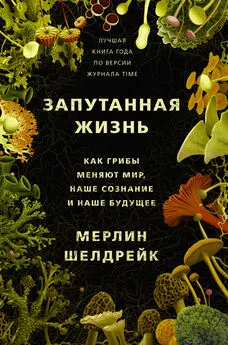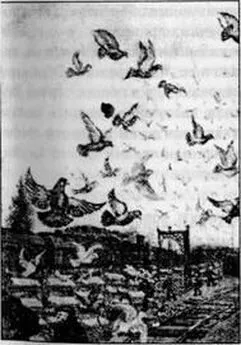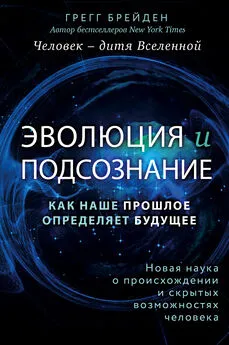Мерлин Шелдрейк - Запутанная жизнь. Как грибы меняют мир, наше сознание и наше будущее
- Название:Запутанная жизнь. Как грибы меняют мир, наше сознание и наше будущее
- Автор:
- Жанр:
- Издательство:Литагент АСТ
- Год:2021
- Город:Москва
- ISBN:978-5-17-122572-8
- Рейтинг:
- Избранное:Добавить в избранное
-
Отзывы:
-
Ваша оценка:
Мерлин Шелдрейк - Запутанная жизнь. Как грибы меняют мир, наше сознание и наше будущее краткое содержание
Талантливый молодой биолог Мерлин Шелдрейк переворачивает мир с ног на голову: он приглашает читателя взглянуть на него с позиции дрожжей, псилоцибиновых грибов, грибов-паразитов и паутины мицелия, которая простирается на многие километры под поверхностью земли (что делает грибы самыми большими живыми организмами на планете). Открывающаяся грибная сущность заставляет пересмотреть наши взгляды на индивидуальность и разум, ведь грибы, как выясняется, – повелители метаболизма, создатели почв и ключевые игроки во множестве естественных процессов. Они способны изменять наше сознание, врачевать тела и даже обратить нависшую над нами экологическую катастрофу. Эти организмы переворачивают наше понимание самой жизни на Земле.
В формате PDF A4 сохранен издательский макет.
Запутанная жизнь. Как грибы меняют мир, наше сознание и наше будущее - читать онлайн бесплатно ознакомительный отрывок
Интервал:
Закладка:
Cerdá-Olmedo E. 2001. Phycomyces and the biology of light and color. FEMS Microbiology Reviews 25: 503–12.
Cernava T, Aschenbrenner I, Soh J, Sensen CW, Grube M, Berg G. 2019. Plasticity of a holobiont: desiccation induces fasting-like metabolism within the lichen microbiota. The ISME Journal 13: 547–56.
Chen J, Blume H, Beyer L. 2000. Weathering of rocks induced by lichen colonization – a review. Catena 39: 121–46.
Chen L, Swenson NG, Ji N, Mi X, Ren H, Guo L, Ma K. 2019. Differential soil fungus accumulation and density dependence of trees in a subtropical forest. Science 366: 124–28.
Chen M, Arato M, Borghi L, Nouri E, Reinhardt D. 2018. Beneficial services of arbuscular mycorrhizal fungi – from ecology to application. Frontiers in Plant Science 9: 1270.
Chialva M, di Fossalunga A, Daghino S, Ghignone S, Bagnaresi P, Chiapello M, Novero M, Spadaro D, Perotto S, Bonfante P. 2018. Native soils with their microbiotas elicit a state of alert in tomato plants. New Phytologist 220: 1296–308.
Chrisafis A. 2010. French truffle farmer shoots man he feared was trying to steal “black diamonds.” The Guardian : www.theguardian.com/world/2010/dec/22/french-truffle-farmer-shoots-trespasser [accessed October 29, 2019].
Christakis NA, Fowler JH. 2009. Connected: The Surprising Power of Our Social Networks and How They Shape Our Lives . London, UK: HarperPress.
Chu C, Murdock MH, Jing D, Won TH, Chung H, Kressel AM, Tsaava T, Addorisio ME, Putzel GG, Zhou L, et al. 2019. The microbiota regulate neuronal function and fear extinction learning. Nature 574: 543–48.
Chung T-Y, Sun P-F, Kuo J-I, Lee Y-I, Lin C–C, Chou J-Y. 2017. Zombie ant heads are oriented relative to solar cues. Fungal Ecology 25: 22–28.
Cixous, H. 1991. The Book of Promethea . Lincoln, NE: University of Nebraska Press.
Claus R, Hoppen H, Karg H. 1981. The secret of truffles: A steroidal pheromone? Experientia 37: 1178–179.
Clay K. 1988. Fungal Endophytes of Grasses: A Defensive Mutualism between Plants and Fungi. Ecology 69: 10–16.
Clemmensen K, Bahr A, Ovaskainen O, Dahlberg A, Ekblad A, Wallander H, Stenlid J, Finlay R, Wardle D, Lindahl B. 2013. Roots and associated fungi drive long-term carbon sequestration in boreal forest. Science 339: 1615–618.
Cockell CS. 2008. The interplanetary exchange of photosynthesis. Origins of Life and Evolution of Biospheres 38: 87–104.
Cohen R, Jan Y, Matricon J, Delbrück M. 1975. Avoidance response, house response, and wind responses of the sporangiophore of Phycomyces. The Journal of General Physiology 66: 67–95.
Collier FA, Bidartondo MI. 2009. Waiting for fungi: the ectomycorrhizal invasion of lowland heathlands. Journal of Ecology 97: 950–63.
Collinge A, Trinci A. 1974. Hyphal tips of wild-type and spreading colonial mutants of Neurospora crassa. Archive of Microbiology 99: 353–68.
Cooke M. 1875. Fungi: Their Nature and Uses . New York, NY: D. Appleton and Company.
Cooley JR, Marshall DC, Hill KBR. 2018. A specialized fungal parasite ( Massospora cicadina ) hijacks the sexual signals of periodical cicadas (Hemiptera: Cicadidae: Magicicada ). Scientific Reports 8: 1432.
Copetta A, Bardi L, Bertolone E, Berta G. 2011. Fruit production and quality of tomato plants ( Solanum lycopersicum L.) are affected by green compost and arbuscular mycorrhizal fungi. Plant Biosystems 145: 106–15.
Copetta A, Lingua G, Berta G. 2006. Effects of three AM fungi on growth, distribution of glandular hairs, and essential oil production in Ocimum basilicum L. var. Genovese. Mycorrhiza 16: 485–94.
Corbin A. 1986. The Foul and the Fragrant: Odor and the French Social Imagination . Leamington Spa, UK: Berg Publishers Ltd.
Cordero RJ. 2017. Melanin for space travel radioprotection. Environmental Microbiology 19: 2529–532.
Corrales A, Mangan SA, Turner BL, Dalling JW. 2016. An ectomycorrhizal nitrogen economy facilitates monodominance in a neotropical forest. Ecology Letters 19: 383–92.
Corrochano LM, Galland P. 2016. “Photomorphogenesis and Gravitropism in Fungi.” In Growth, Differentiation, and Sexuality . Wendland J, ed. Springer International Publishing, pp. 235–66.
Cosme M, Fernández I, van der Heijden MG, Pieterse C. 2018. Non-mycorrhizal Plants: The Exceptions that Prove the Rule. Trends in Plant Science 23: 577–87.
Costello EK, Lauber CL, Hamady M, Fierer N, Gordon JI, Knight R. 2009. Bacterial community variation in human body habitats across space and time. Science 326: 1694–697.
Cottin H, Kotler J, Billi D, Cockell C, Demets R, Ehrenfreund P, Elsaesser A, d’Hendecourt L, van Loon JJ, Martins Z, et al. 2017. Space as a tool for astrobiology: review and recommendations for experimentations in earth orbit and beyond. Space Science Reviews 209: 83–181.
Coyle MC, Elya CN, Bronski MJ, Eisen MB. 2018. Entomophthovirus: An insect-derived iflavirus that infects a behavior manipulating fungal pathogen of dipterans. bioRxiv : 371526.
Craig ME, Turner BL, Liang C, Clay K, Johnson DJ, Phillips RP. 2018. Tree mycorrhizal type predicts within-site variability in the storage and distribution of soil organic matter. Global Change Biology 24: 3317–330.
Crowther T, Glick H, Covey K, Bettigole C, Maynard D, Thomas S, Smith J, Hintler G, Duguid M, Amatulli G, et al. 2015. Mapping tree density at a global scale. Nature 525: 201–68.
Currie CR, Poulsen M, Mendenhall J, Boomsma JJ, Billen J. 2006. Coevolved crypts and exocrine glands support mutualistic bacteria in fungus-growing ants. Science 311: 81–83.
Currie CR, Scott JA, Summerbell RC, Malloch D. 1999. Fungus-growing ants use antibiotic-producing bacteria to control garden parasites. Nature 398: 701–04.
Dadachova E, Casadevall A. 2008. Ionizing radiation: how fungi cope, adapt, and exploit with the help of melanin. Current Opinion in Microbiology 11: 525–31.
Dance A. 2018. Inner Workings: The mysterious parentage of the coveted black truffle. Proceedings of the National Academy of Sciences 115: 10188–190.
Darwin C, Darwin F. 1880. The Power of Movement in Plants . London, UK: John Murray.
Davis J, Aguirre L, Barber N, Stevenson P, Adler L. 2019. From plant fungi to bee parasites: mycorrhizae and soil nutrients shape floral chemistry and bee pathogens. Ecology 100: e02801.
Davis W. 1996. One River: Explorations and Discoveries in the Amazon Rain Forest . New York, NY: Simon and Schuster.
Dawkins R. 1982. The Extended Phenotype . Oxford, UK: Oxford University Press.
Dawkins R. 2004. Extended Phenotype – But Not Too Extended. A Reply to Laland, Turner and Jablonka. Biology and Philosophy 19: 377–96.
de Bekker C, Quevillon LE, Smith PB, Fleming KR, Ghosh D, Patterson AD, Hughes DP. 2014. Species-specific ant brain manipulation by a specialized fungal parasite. BMC Evolutionary Biology 14: 166.
de Gonzalo G, Colpa DI, Habib M, Fraaije MW. 2016. Bacterial enzymes involved in lignin degradation. Journal of Biotechnology 236: 110–19.
de Jong E, Field JA, Spinnler HE, Wijnberg JB, de Bont JA. 1994. Significant biogenesis of chlorinated aromatics by fungi in natural environments. Applied and Environmental Microbiology 60: 264–70.
de la Fuente-Nunez C, Meneguetti B, Franco O, Lu TK. 2017. Neuromicrobiology: how microbes influence the brain. ACS Chemical Neuroscience 9: 141–50.
de la Torre R, Miller AZ, Cubero B, Martín-Cerezo LM, Raguse M, Meeßen J. 2017. The effect of high-dose ionizing radiation on the astrobiological model lichen Circinaria gyrosa. Astrobiology 17: 145–53.
de la Torre Noetzel R, Miller AZ, de la Rosa JM, Pacelli C, Onofri S, Sancho L, Cubero B, Lorek A, Wolter D, de Vera JP. 2018. Cellular responses of the lichen Circinaria gyrosa in Mars-like conditions. Frontiers in Microbiology 9: 308.
Delaux PM, Radhakrishnan GV, Jayaraman D, Cheema J, Malbreil M, Volkening JD, Sekimoto H, Nishiyama T, Melkonian M, Pokorny L, et al. 2015. Algal ancestor of land plants was preadapted for symbiosis. Proceedings of the National Academy of Sciences 112: 13390–395.
Delavaux CS, Smith-Ramesh L, Kuebbing SE. 2017. Beyond nutrients: a meta-analysis of the diverse effects of arbuscular mycorrhizal fungi on plants and soils. Ecology 98: 2111–119.
Deleuze G, Guattari F. 2005. A Thousand Plateaus: Capitalism and Schizophrenia. Minneapolis, MN: University of Minnesota Press.
de los Ríos A, Sancho L, Grube M, Wierzchos J, Ascaso C. 2005. Endolithic growth of two Lecidea lichens in granite from continental Antarctica detected by molecular and microscopy techniques. New Phytologist 165: 181–90.
Delwiche C, Cooper E. 2015. The evolutionary origin of a terrestrial flora. Current Biology 25: R899–R910.
Deng Y, Qu Z, Naqvi NI. 2015. Twilight, a novel circadian-regulated gene, integrates phototropism with nutrient and redox homeostasis during fungal development. PLOS Pathogens 11: e1004972.
Deveau A, Bonito G, Uehling J, Paoletti M, Becker M, Bindschedler S, Hacquard S, Hervé V, Labbé J, Lastovetsky O, et al. 2018. Bacterial-fungal interactions: ecology, mechanisms and challenges. FEMS Microbiology Reviews 42: 335–52.
de Vera JP, Alawi M, Backhaus T, Baqué M, Billi D, Böttger U, Berger T, Bohmeier M, Cockell C, Demets R, et al. 2019. Limits of life and the habitability of Mars: The ESA Space Experiment BIOMEX on the ISS. Astrobiology 19: 145–57.
de Vries FT, Thébault E, Liiri M, Birkhofer K, Tsiafouli MA, Bjørnlund L, Jørgensen H, Brady M, Christensen S, de Ruiter PC, et al. 2013. Soil food web properties explain ecosystem services across European land use systems. Proceedings of the National Academy of Sciences 110: 14296–301.
de Waal FBM. 1999. Anthropomorphism and Anthropodenial: Consistency in Our Thinking about Humans and Other Animals. Philosophical Topics 27: 255–80.
Diamant L. 2004. Chaining the Hudson: The Fight for the River in the American Revolution . New York, NY: Fordham University Press.
di Fossalunga A, Lipuma J, Venice F, Dupont L, Bonfante P. 2017. The endobacterium of an arbuscular mycorrhizal fungus modulates the expression of its toxin – antitoxin systems during the life cycle of its host. The ISME Journal 11: 2394–398.
Ditengou FA, Müller A, Rosenkranz M, Felten J, Lasok H, van Doorn M, Legué V, Palme K, Schnitzler J-P, Polle A. 2015. Volatile signalling by sesquiterpenes from ectomycorrhizal fungi reprogrammes root architecture. Nature Communications 6: 6279.
Dixon LS. 1984. Bosch’s “St. Anthony Triptych”—An Apothecary’s Apotheosis. Art Journal 44: 119–31.
Donoghue PC, Antcliffe JB. 2010. Early life: origins of multicellularity. Nature 466: 41.
Doolittle FW, Booth A. 2017. It’s the song, not the singer: an exploration of holobiosis and evolutionary theory. Biology & Philosophy 32: 5–24.
Dressaire E, Yamada L, Song B, Roper M. 2016. Mushrooms use convectively created airflows to disperse their spores. Proceedings of the National Academy of Sciences 113: 2833–838.
Dudley R. 2014. The Drunken Monkey: Why We Drink and Abuse Alcohol . Berkeley, CA: University of California Press.
Читать дальшеИнтервал:
Закладка:









